University Health and Social Care Management Report, Unit 3
VerifiedAdded on 2022/08/13
|44
|12228
|21
Report
AI Summary
This report, prepared by a student, delves into the core concepts of health and social care management. It begins by defining health and illness, contrasting different models such as the social, medical, and biopsychosocial approaches. The report then examines various factors influencing health and wellbeing, including socioeconomic, physical, and behavioral elements. It explores the impact of social class, culture, ethnicity, genetics, and aging-related diseases. Behavioral factors such as alcohol misuse, poor diet, and the connection between diet, exercise, and health are also analyzed. Furthermore, the report discusses the role of media in shaping attitudes towards health, highlighting the potential for both positive and negative influences. This comprehensive analysis provides a detailed overview of the multifaceted nature of health and social care management.
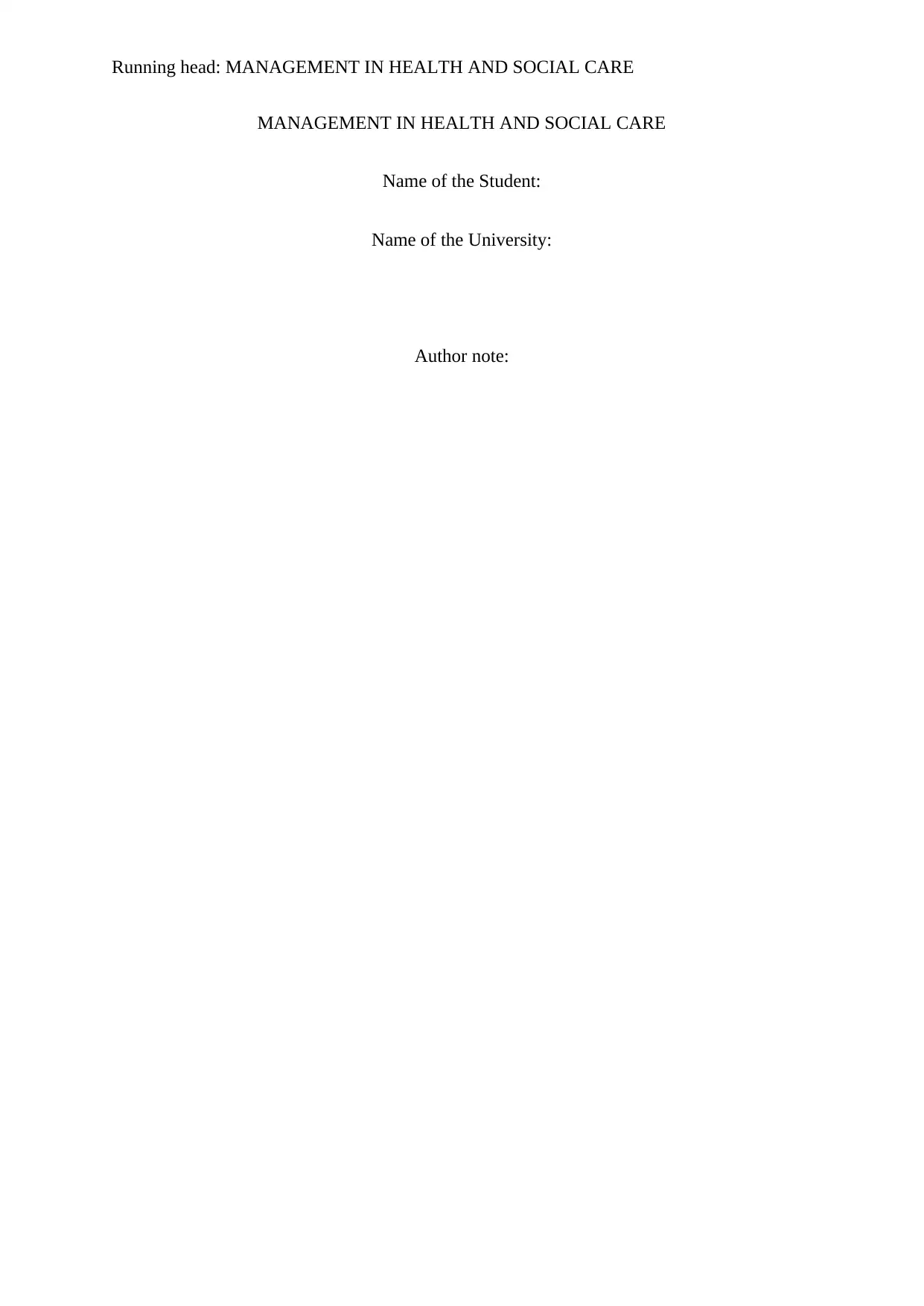
Running head: MANAGEMENT IN HEALTH AND SOCIAL CARE
MANAGEMENT IN HEALTH AND SOCIAL CARE
Name of the Student:
Name of the University:
Author note:
MANAGEMENT IN HEALTH AND SOCIAL CARE
Name of the Student:
Name of the University:
Author note:
Paraphrase This Document
Need a fresh take? Get an instant paraphrase of this document with our AI Paraphraser
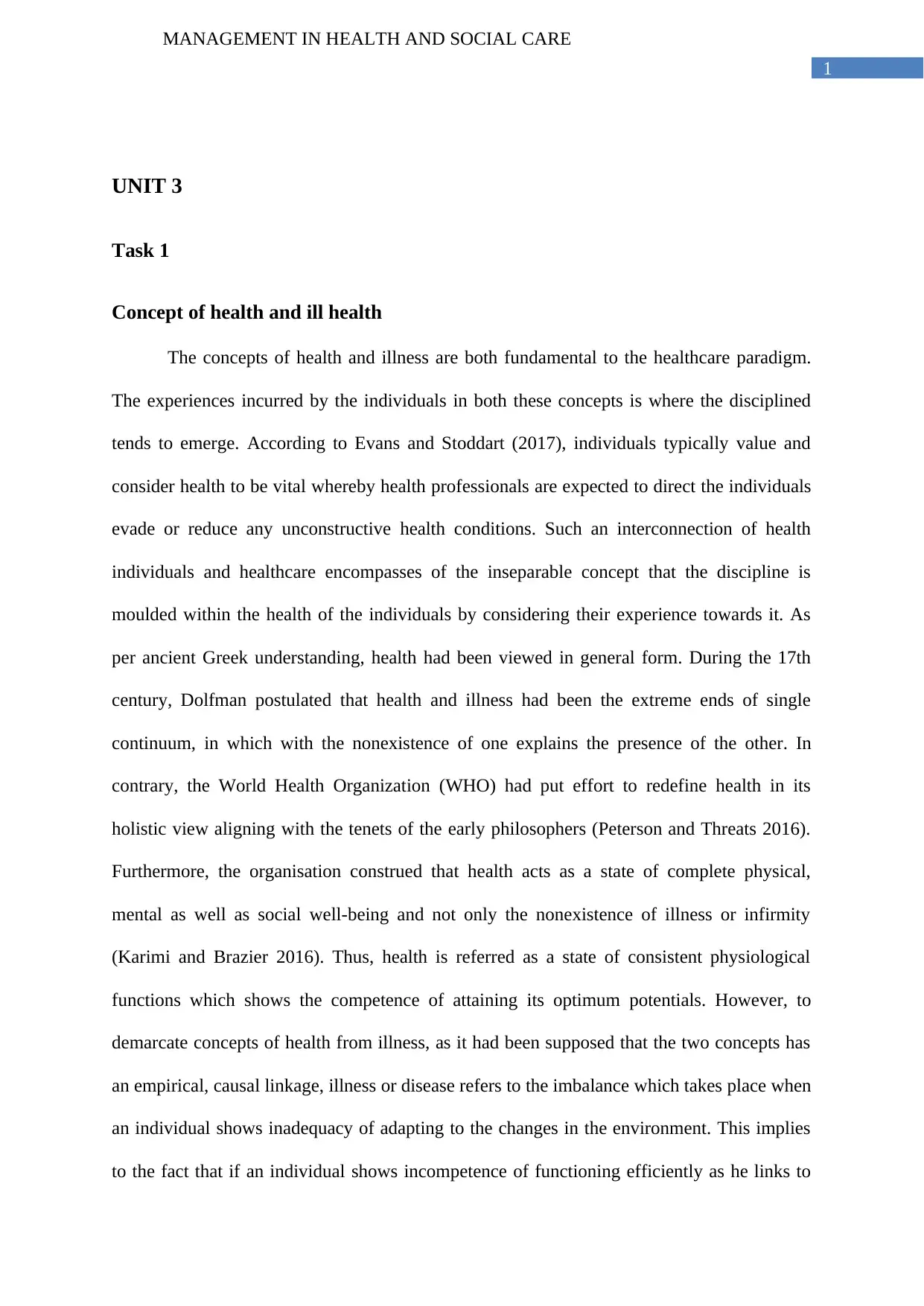
1
MANAGEMENT IN HEALTH AND SOCIAL CARE
UNIT 3
Task 1
Concept of health and ill health
The concepts of health and illness are both fundamental to the healthcare paradigm.
The experiences incurred by the individuals in both these concepts is where the disciplined
tends to emerge. According to Evans and Stoddart (2017), individuals typically value and
consider health to be vital whereby health professionals are expected to direct the individuals
evade or reduce any unconstructive health conditions. Such an interconnection of health
individuals and healthcare encompasses of the inseparable concept that the discipline is
moulded within the health of the individuals by considering their experience towards it. As
per ancient Greek understanding, health had been viewed in general form. During the 17th
century, Dolfman postulated that health and illness had been the extreme ends of single
continuum, in which with the nonexistence of one explains the presence of the other. In
contrary, the World Health Organization (WHO) had put effort to redefine health in its
holistic view aligning with the tenets of the early philosophers (Peterson and Threats 2016).
Furthermore, the organisation construed that health acts as a state of complete physical,
mental as well as social well-being and not only the nonexistence of illness or infirmity
(Karimi and Brazier 2016). Thus, health is referred as a state of consistent physiological
functions which shows the competence of attaining its optimum potentials. However, to
demarcate concepts of health from illness, as it had been supposed that the two concepts has
an empirical, causal linkage, illness or disease refers to the imbalance which takes place when
an individual shows inadequacy of adapting to the changes in the environment. This implies
to the fact that if an individual shows incompetence of functioning efficiently as he links to
MANAGEMENT IN HEALTH AND SOCIAL CARE
UNIT 3
Task 1
Concept of health and ill health
The concepts of health and illness are both fundamental to the healthcare paradigm.
The experiences incurred by the individuals in both these concepts is where the disciplined
tends to emerge. According to Evans and Stoddart (2017), individuals typically value and
consider health to be vital whereby health professionals are expected to direct the individuals
evade or reduce any unconstructive health conditions. Such an interconnection of health
individuals and healthcare encompasses of the inseparable concept that the discipline is
moulded within the health of the individuals by considering their experience towards it. As
per ancient Greek understanding, health had been viewed in general form. During the 17th
century, Dolfman postulated that health and illness had been the extreme ends of single
continuum, in which with the nonexistence of one explains the presence of the other. In
contrary, the World Health Organization (WHO) had put effort to redefine health in its
holistic view aligning with the tenets of the early philosophers (Peterson and Threats 2016).
Furthermore, the organisation construed that health acts as a state of complete physical,
mental as well as social well-being and not only the nonexistence of illness or infirmity
(Karimi and Brazier 2016). Thus, health is referred as a state of consistent physiological
functions which shows the competence of attaining its optimum potentials. However, to
demarcate concepts of health from illness, as it had been supposed that the two concepts has
an empirical, causal linkage, illness or disease refers to the imbalance which takes place when
an individual shows inadequacy of adapting to the changes in the environment. This implies
to the fact that if an individual shows incompetence of functioning efficiently as he links to
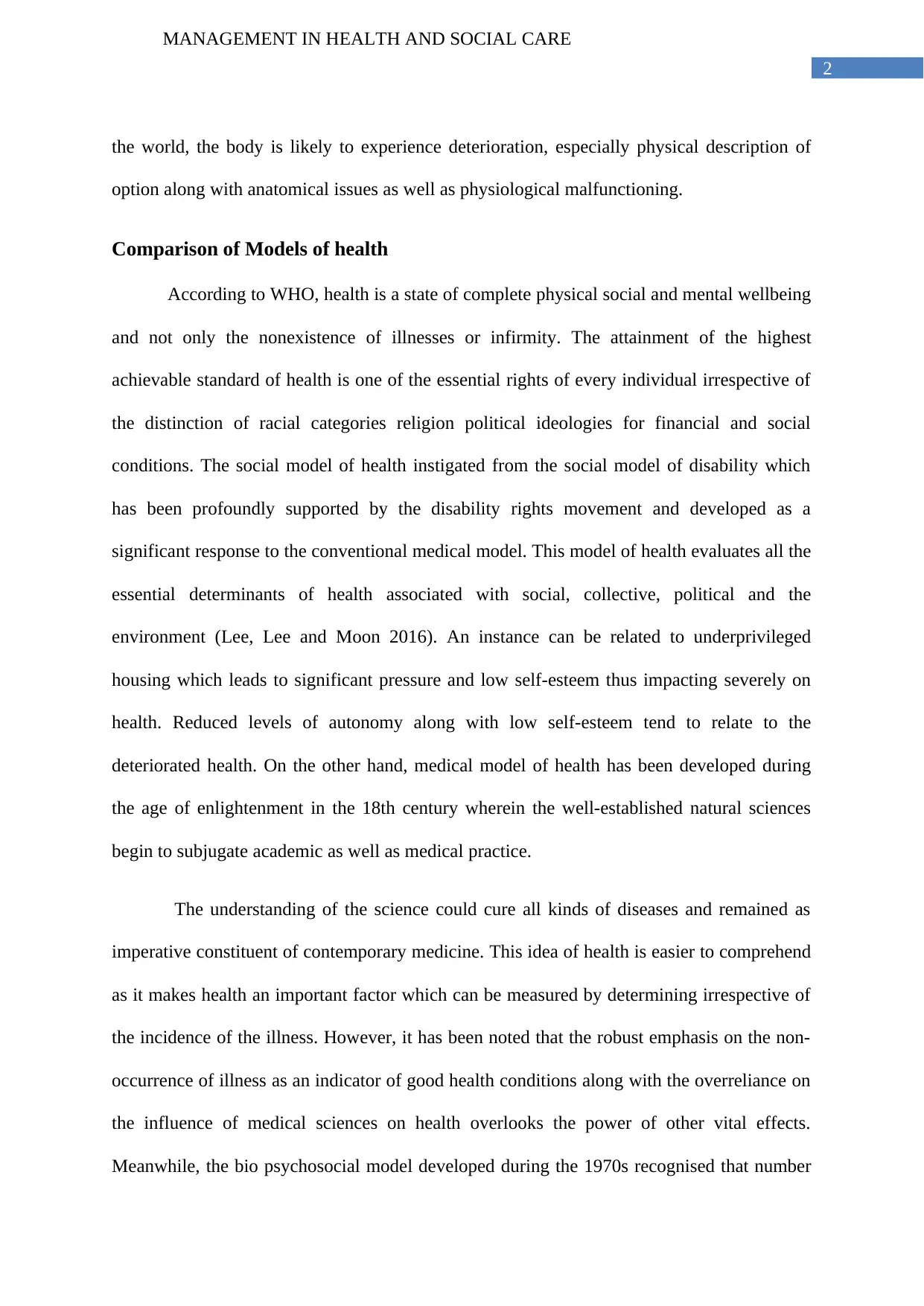
2
MANAGEMENT IN HEALTH AND SOCIAL CARE
the world, the body is likely to experience deterioration, especially physical description of
option along with anatomical issues as well as physiological malfunctioning.
Comparison of Models of health
According to WHO, health is a state of complete physical social and mental wellbeing
and not only the nonexistence of illnesses or infirmity. The attainment of the highest
achievable standard of health is one of the essential rights of every individual irrespective of
the distinction of racial categories religion political ideologies for financial and social
conditions. The social model of health instigated from the social model of disability which
has been profoundly supported by the disability rights movement and developed as a
significant response to the conventional medical model. This model of health evaluates all the
essential determinants of health associated with social, collective, political and the
environment (Lee, Lee and Moon 2016). An instance can be related to underprivileged
housing which leads to significant pressure and low self-esteem thus impacting severely on
health. Reduced levels of autonomy along with low self-esteem tend to relate to the
deteriorated health. On the other hand, medical model of health has been developed during
the age of enlightenment in the 18th century wherein the well-established natural sciences
begin to subjugate academic as well as medical practice.
The understanding of the science could cure all kinds of diseases and remained as
imperative constituent of contemporary medicine. This idea of health is easier to comprehend
as it makes health an important factor which can be measured by determining irrespective of
the incidence of the illness. However, it has been noted that the robust emphasis on the non-
occurrence of illness as an indicator of good health conditions along with the overreliance on
the influence of medical sciences on health overlooks the power of other vital effects.
Meanwhile, the bio psychosocial model developed during the 1970s recognised that number
MANAGEMENT IN HEALTH AND SOCIAL CARE
the world, the body is likely to experience deterioration, especially physical description of
option along with anatomical issues as well as physiological malfunctioning.
Comparison of Models of health
According to WHO, health is a state of complete physical social and mental wellbeing
and not only the nonexistence of illnesses or infirmity. The attainment of the highest
achievable standard of health is one of the essential rights of every individual irrespective of
the distinction of racial categories religion political ideologies for financial and social
conditions. The social model of health instigated from the social model of disability which
has been profoundly supported by the disability rights movement and developed as a
significant response to the conventional medical model. This model of health evaluates all the
essential determinants of health associated with social, collective, political and the
environment (Lee, Lee and Moon 2016). An instance can be related to underprivileged
housing which leads to significant pressure and low self-esteem thus impacting severely on
health. Reduced levels of autonomy along with low self-esteem tend to relate to the
deteriorated health. On the other hand, medical model of health has been developed during
the age of enlightenment in the 18th century wherein the well-established natural sciences
begin to subjugate academic as well as medical practice.
The understanding of the science could cure all kinds of diseases and remained as
imperative constituent of contemporary medicine. This idea of health is easier to comprehend
as it makes health an important factor which can be measured by determining irrespective of
the incidence of the illness. However, it has been noted that the robust emphasis on the non-
occurrence of illness as an indicator of good health conditions along with the overreliance on
the influence of medical sciences on health overlooks the power of other vital effects.
Meanwhile, the bio psychosocial model developed during the 1970s recognised that number
⊘ This is a preview!⊘
Do you want full access?
Subscribe today to unlock all pages.

Trusted by 1+ million students worldwide
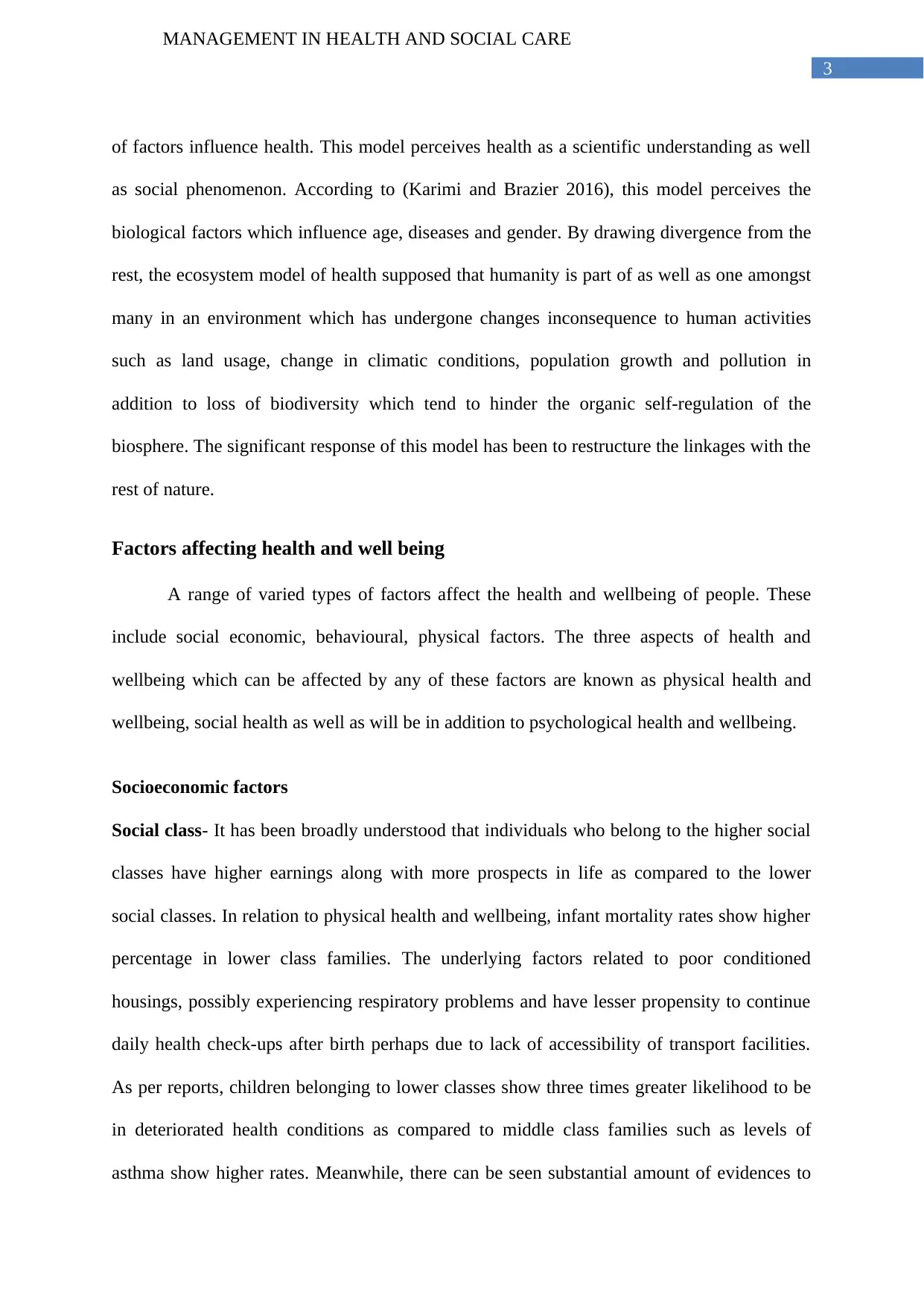
3
MANAGEMENT IN HEALTH AND SOCIAL CARE
of factors influence health. This model perceives health as a scientific understanding as well
as social phenomenon. According to (Karimi and Brazier 2016), this model perceives the
biological factors which influence age, diseases and gender. By drawing divergence from the
rest, the ecosystem model of health supposed that humanity is part of as well as one amongst
many in an environment which has undergone changes inconsequence to human activities
such as land usage, change in climatic conditions, population growth and pollution in
addition to loss of biodiversity which tend to hinder the organic self-regulation of the
biosphere. The significant response of this model has been to restructure the linkages with the
rest of nature.
Factors affecting health and well being
A range of varied types of factors affect the health and wellbeing of people. These
include social economic, behavioural, physical factors. The three aspects of health and
wellbeing which can be affected by any of these factors are known as physical health and
wellbeing, social health as well as will be in addition to psychological health and wellbeing.
Socioeconomic factors
Social class- It has been broadly understood that individuals who belong to the higher social
classes have higher earnings along with more prospects in life as compared to the lower
social classes. In relation to physical health and wellbeing, infant mortality rates show higher
percentage in lower class families. The underlying factors related to poor conditioned
housings, possibly experiencing respiratory problems and have lesser propensity to continue
daily health check-ups after birth perhaps due to lack of accessibility of transport facilities.
As per reports, children belonging to lower classes show three times greater likelihood to be
in deteriorated health conditions as compared to middle class families such as levels of
asthma show higher rates. Meanwhile, there can be seen substantial amount of evidences to
MANAGEMENT IN HEALTH AND SOCIAL CARE
of factors influence health. This model perceives health as a scientific understanding as well
as social phenomenon. According to (Karimi and Brazier 2016), this model perceives the
biological factors which influence age, diseases and gender. By drawing divergence from the
rest, the ecosystem model of health supposed that humanity is part of as well as one amongst
many in an environment which has undergone changes inconsequence to human activities
such as land usage, change in climatic conditions, population growth and pollution in
addition to loss of biodiversity which tend to hinder the organic self-regulation of the
biosphere. The significant response of this model has been to restructure the linkages with the
rest of nature.
Factors affecting health and well being
A range of varied types of factors affect the health and wellbeing of people. These
include social economic, behavioural, physical factors. The three aspects of health and
wellbeing which can be affected by any of these factors are known as physical health and
wellbeing, social health as well as will be in addition to psychological health and wellbeing.
Socioeconomic factors
Social class- It has been broadly understood that individuals who belong to the higher social
classes have higher earnings along with more prospects in life as compared to the lower
social classes. In relation to physical health and wellbeing, infant mortality rates show higher
percentage in lower class families. The underlying factors related to poor conditioned
housings, possibly experiencing respiratory problems and have lesser propensity to continue
daily health check-ups after birth perhaps due to lack of accessibility of transport facilities.
As per reports, children belonging to lower classes show three times greater likelihood to be
in deteriorated health conditions as compared to middle class families such as levels of
asthma show higher rates. Meanwhile, there can be seen substantial amount of evidences to
Paraphrase This Document
Need a fresh take? Get an instant paraphrase of this document with our AI Paraphraser
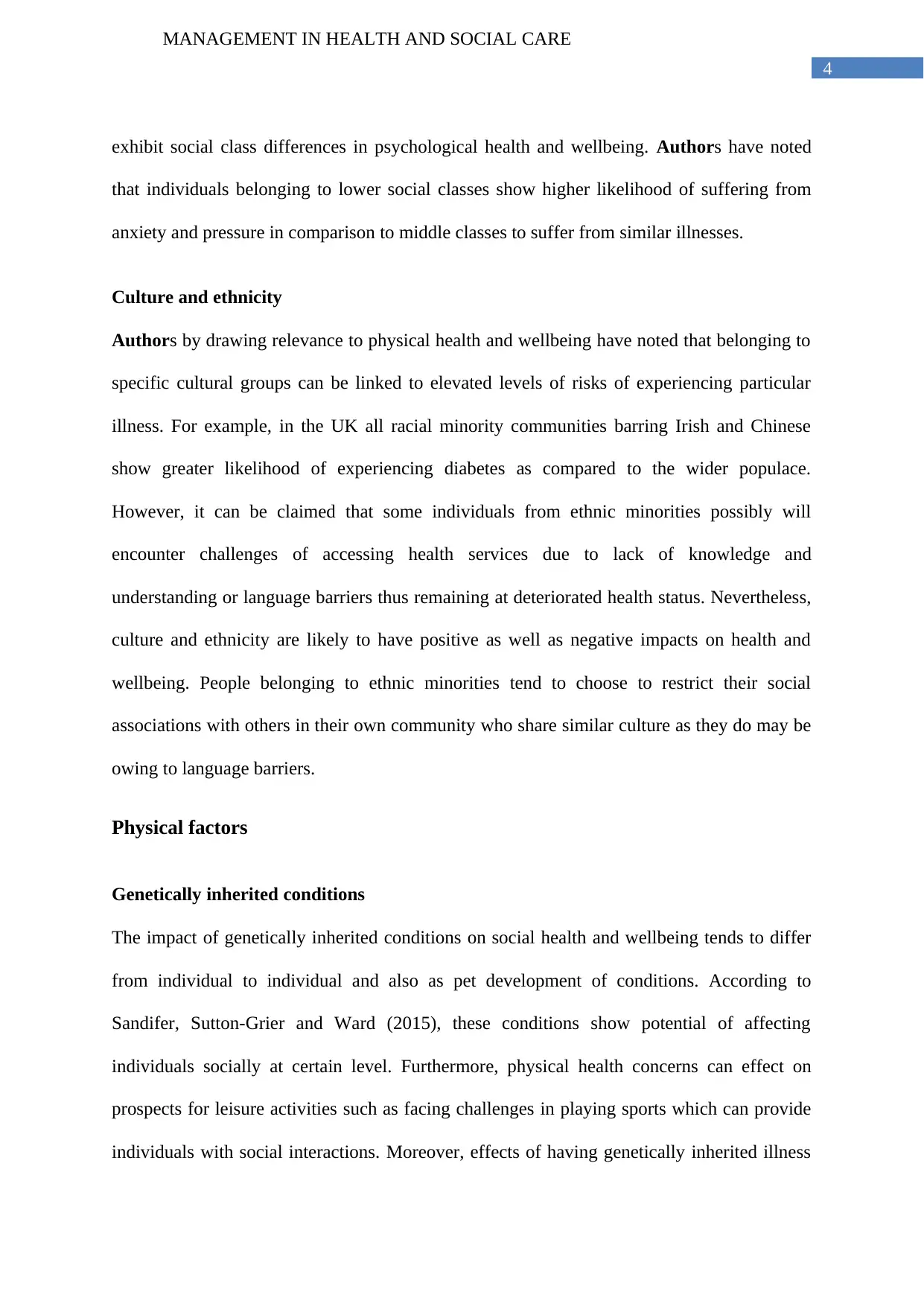
4
MANAGEMENT IN HEALTH AND SOCIAL CARE
exhibit social class differences in psychological health and wellbeing. Authors have noted
that individuals belonging to lower social classes show higher likelihood of suffering from
anxiety and pressure in comparison to middle classes to suffer from similar illnesses.
Culture and ethnicity
Authors by drawing relevance to physical health and wellbeing have noted that belonging to
specific cultural groups can be linked to elevated levels of risks of experiencing particular
illness. For example, in the UK all racial minority communities barring Irish and Chinese
show greater likelihood of experiencing diabetes as compared to the wider populace.
However, it can be claimed that some individuals from ethnic minorities possibly will
encounter challenges of accessing health services due to lack of knowledge and
understanding or language barriers thus remaining at deteriorated health status. Nevertheless,
culture and ethnicity are likely to have positive as well as negative impacts on health and
wellbeing. People belonging to ethnic minorities tend to choose to restrict their social
associations with others in their own community who share similar culture as they do may be
owing to language barriers.
Physical factors
Genetically inherited conditions
The impact of genetically inherited conditions on social health and wellbeing tends to differ
from individual to individual and also as pet development of conditions. According to
Sandifer, Sutton-Grier and Ward (2015), these conditions show potential of affecting
individuals socially at certain level. Furthermore, physical health concerns can effect on
prospects for leisure activities such as facing challenges in playing sports which can provide
individuals with social interactions. Moreover, effects of having genetically inherited illness
MANAGEMENT IN HEALTH AND SOCIAL CARE
exhibit social class differences in psychological health and wellbeing. Authors have noted
that individuals belonging to lower social classes show higher likelihood of suffering from
anxiety and pressure in comparison to middle classes to suffer from similar illnesses.
Culture and ethnicity
Authors by drawing relevance to physical health and wellbeing have noted that belonging to
specific cultural groups can be linked to elevated levels of risks of experiencing particular
illness. For example, in the UK all racial minority communities barring Irish and Chinese
show greater likelihood of experiencing diabetes as compared to the wider populace.
However, it can be claimed that some individuals from ethnic minorities possibly will
encounter challenges of accessing health services due to lack of knowledge and
understanding or language barriers thus remaining at deteriorated health status. Nevertheless,
culture and ethnicity are likely to have positive as well as negative impacts on health and
wellbeing. People belonging to ethnic minorities tend to choose to restrict their social
associations with others in their own community who share similar culture as they do may be
owing to language barriers.
Physical factors
Genetically inherited conditions
The impact of genetically inherited conditions on social health and wellbeing tends to differ
from individual to individual and also as pet development of conditions. According to
Sandifer, Sutton-Grier and Ward (2015), these conditions show potential of affecting
individuals socially at certain level. Furthermore, physical health concerns can effect on
prospects for leisure activities such as facing challenges in playing sports which can provide
individuals with social interactions. Moreover, effects of having genetically inherited illness
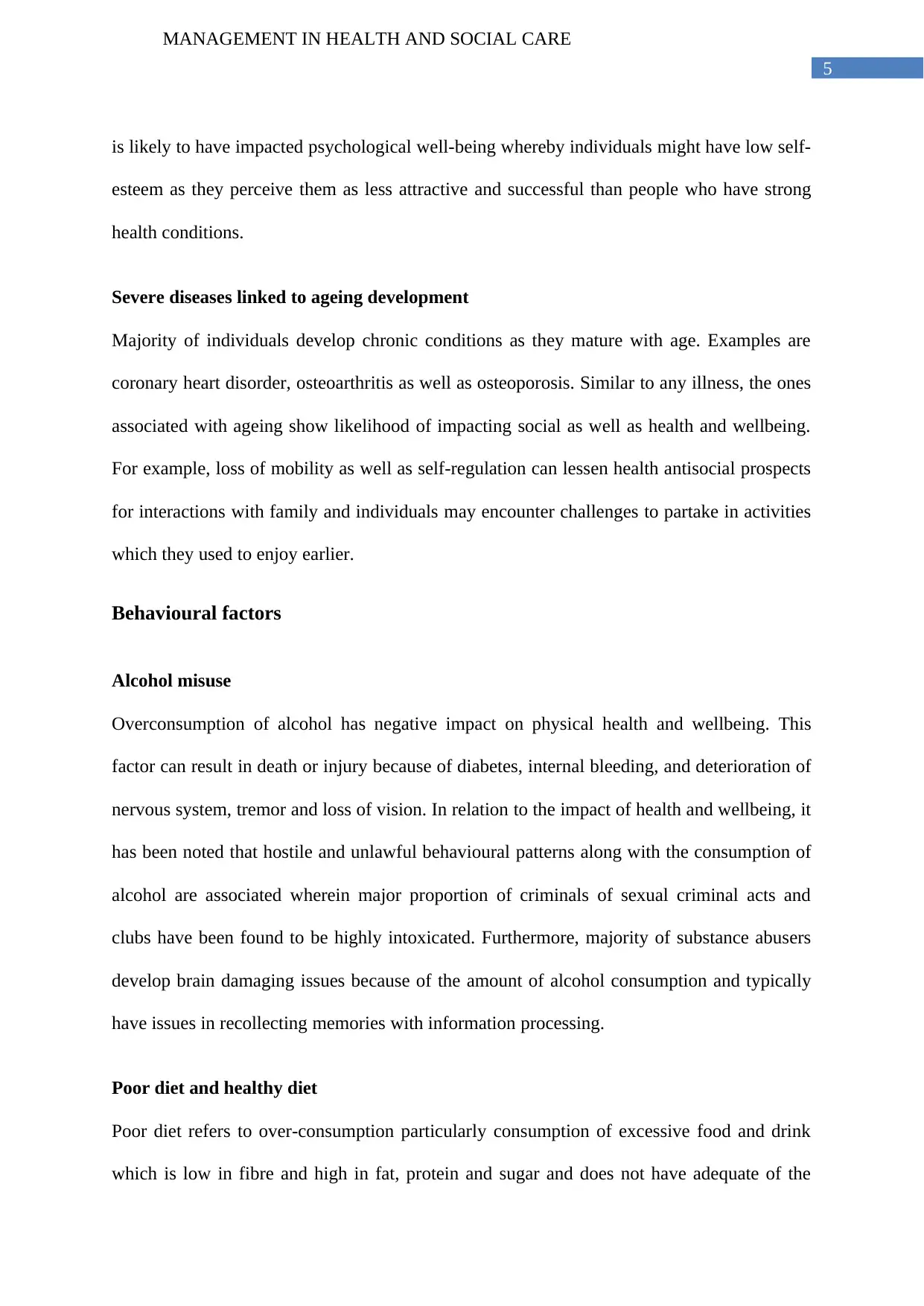
5
MANAGEMENT IN HEALTH AND SOCIAL CARE
is likely to have impacted psychological well-being whereby individuals might have low self-
esteem as they perceive them as less attractive and successful than people who have strong
health conditions.
Severe diseases linked to ageing development
Majority of individuals develop chronic conditions as they mature with age. Examples are
coronary heart disorder, osteoarthritis as well as osteoporosis. Similar to any illness, the ones
associated with ageing show likelihood of impacting social as well as health and wellbeing.
For example, loss of mobility as well as self-regulation can lessen health antisocial prospects
for interactions with family and individuals may encounter challenges to partake in activities
which they used to enjoy earlier.
Behavioural factors
Alcohol misuse
Overconsumption of alcohol has negative impact on physical health and wellbeing. This
factor can result in death or injury because of diabetes, internal bleeding, and deterioration of
nervous system, tremor and loss of vision. In relation to the impact of health and wellbeing, it
has been noted that hostile and unlawful behavioural patterns along with the consumption of
alcohol are associated wherein major proportion of criminals of sexual criminal acts and
clubs have been found to be highly intoxicated. Furthermore, majority of substance abusers
develop brain damaging issues because of the amount of alcohol consumption and typically
have issues in recollecting memories with information processing.
Poor diet and healthy diet
Poor diet refers to over-consumption particularly consumption of excessive food and drink
which is low in fibre and high in fat, protein and sugar and does not have adequate of the
MANAGEMENT IN HEALTH AND SOCIAL CARE
is likely to have impacted psychological well-being whereby individuals might have low self-
esteem as they perceive them as less attractive and successful than people who have strong
health conditions.
Severe diseases linked to ageing development
Majority of individuals develop chronic conditions as they mature with age. Examples are
coronary heart disorder, osteoarthritis as well as osteoporosis. Similar to any illness, the ones
associated with ageing show likelihood of impacting social as well as health and wellbeing.
For example, loss of mobility as well as self-regulation can lessen health antisocial prospects
for interactions with family and individuals may encounter challenges to partake in activities
which they used to enjoy earlier.
Behavioural factors
Alcohol misuse
Overconsumption of alcohol has negative impact on physical health and wellbeing. This
factor can result in death or injury because of diabetes, internal bleeding, and deterioration of
nervous system, tremor and loss of vision. In relation to the impact of health and wellbeing, it
has been noted that hostile and unlawful behavioural patterns along with the consumption of
alcohol are associated wherein major proportion of criminals of sexual criminal acts and
clubs have been found to be highly intoxicated. Furthermore, majority of substance abusers
develop brain damaging issues because of the amount of alcohol consumption and typically
have issues in recollecting memories with information processing.
Poor diet and healthy diet
Poor diet refers to over-consumption particularly consumption of excessive food and drink
which is low in fibre and high in fat, protein and sugar and does not have adequate of the
⊘ This is a preview!⊘
Do you want full access?
Subscribe today to unlock all pages.

Trusted by 1+ million students worldwide
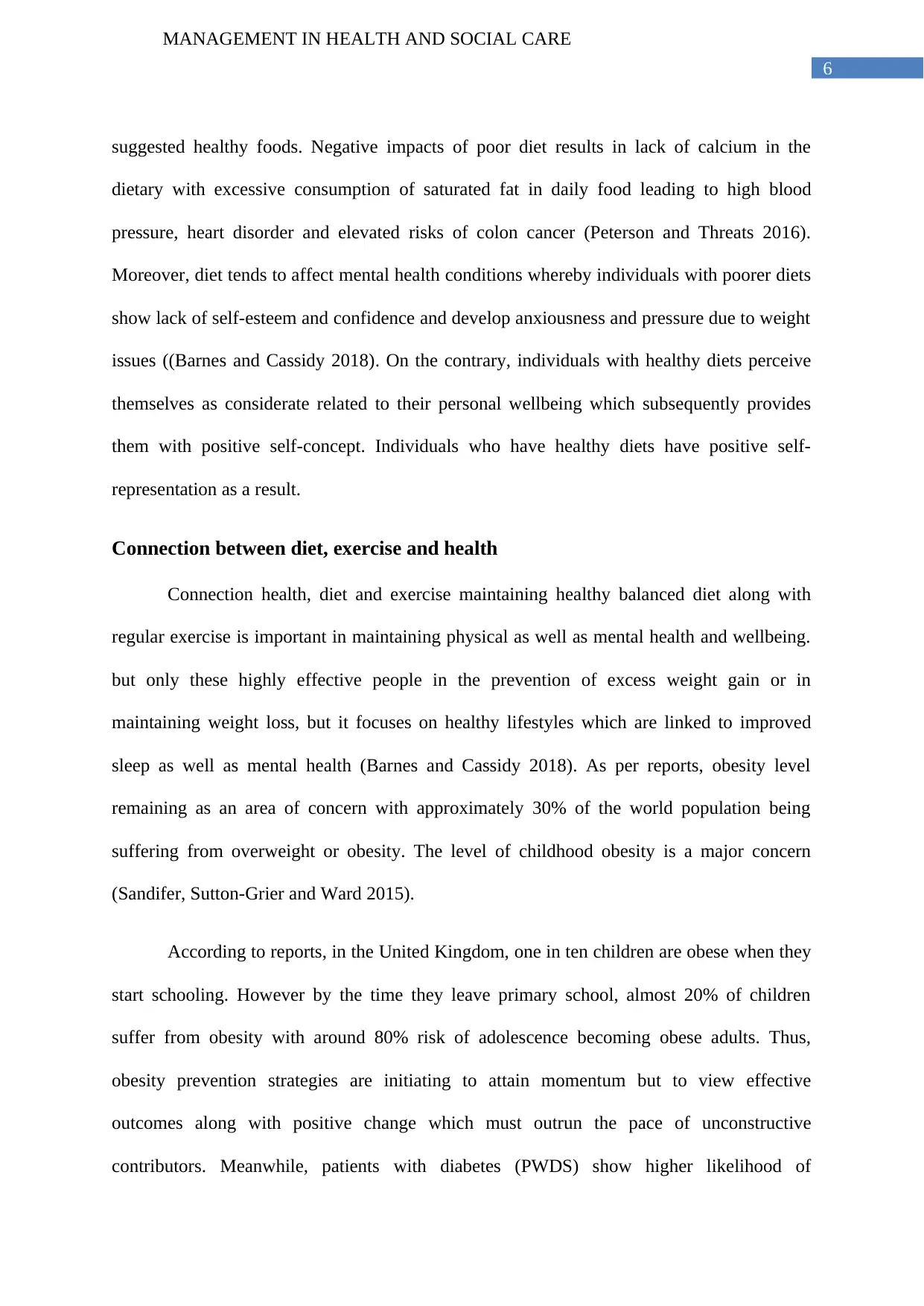
6
MANAGEMENT IN HEALTH AND SOCIAL CARE
suggested healthy foods. Negative impacts of poor diet results in lack of calcium in the
dietary with excessive consumption of saturated fat in daily food leading to high blood
pressure, heart disorder and elevated risks of colon cancer (Peterson and Threats 2016).
Moreover, diet tends to affect mental health conditions whereby individuals with poorer diets
show lack of self-esteem and confidence and develop anxiousness and pressure due to weight
issues ((Barnes and Cassidy 2018). On the contrary, individuals with healthy diets perceive
themselves as considerate related to their personal wellbeing which subsequently provides
them with positive self-concept. Individuals who have healthy diets have positive self-
representation as a result.
Connection between diet, exercise and health
Connection health, diet and exercise maintaining healthy balanced diet along with
regular exercise is important in maintaining physical as well as mental health and wellbeing.
but only these highly effective people in the prevention of excess weight gain or in
maintaining weight loss, but it focuses on healthy lifestyles which are linked to improved
sleep as well as mental health (Barnes and Cassidy 2018). As per reports, obesity level
remaining as an area of concern with approximately 30% of the world population being
suffering from overweight or obesity. The level of childhood obesity is a major concern
(Sandifer, Sutton-Grier and Ward 2015).
According to reports, in the United Kingdom, one in ten children are obese when they
start schooling. However by the time they leave primary school, almost 20% of children
suffer from obesity with around 80% risk of adolescence becoming obese adults. Thus,
obesity prevention strategies are initiating to attain momentum but to view effective
outcomes along with positive change which must outrun the pace of unconstructive
contributors. Meanwhile, patients with diabetes (PWDS) show higher likelihood of
MANAGEMENT IN HEALTH AND SOCIAL CARE
suggested healthy foods. Negative impacts of poor diet results in lack of calcium in the
dietary with excessive consumption of saturated fat in daily food leading to high blood
pressure, heart disorder and elevated risks of colon cancer (Peterson and Threats 2016).
Moreover, diet tends to affect mental health conditions whereby individuals with poorer diets
show lack of self-esteem and confidence and develop anxiousness and pressure due to weight
issues ((Barnes and Cassidy 2018). On the contrary, individuals with healthy diets perceive
themselves as considerate related to their personal wellbeing which subsequently provides
them with positive self-concept. Individuals who have healthy diets have positive self-
representation as a result.
Connection between diet, exercise and health
Connection health, diet and exercise maintaining healthy balanced diet along with
regular exercise is important in maintaining physical as well as mental health and wellbeing.
but only these highly effective people in the prevention of excess weight gain or in
maintaining weight loss, but it focuses on healthy lifestyles which are linked to improved
sleep as well as mental health (Barnes and Cassidy 2018). As per reports, obesity level
remaining as an area of concern with approximately 30% of the world population being
suffering from overweight or obesity. The level of childhood obesity is a major concern
(Sandifer, Sutton-Grier and Ward 2015).
According to reports, in the United Kingdom, one in ten children are obese when they
start schooling. However by the time they leave primary school, almost 20% of children
suffer from obesity with around 80% risk of adolescence becoming obese adults. Thus,
obesity prevention strategies are initiating to attain momentum but to view effective
outcomes along with positive change which must outrun the pace of unconstructive
contributors. Meanwhile, patients with diabetes (PWDS) show higher likelihood of
Paraphrase This Document
Need a fresh take? Get an instant paraphrase of this document with our AI Paraphraser
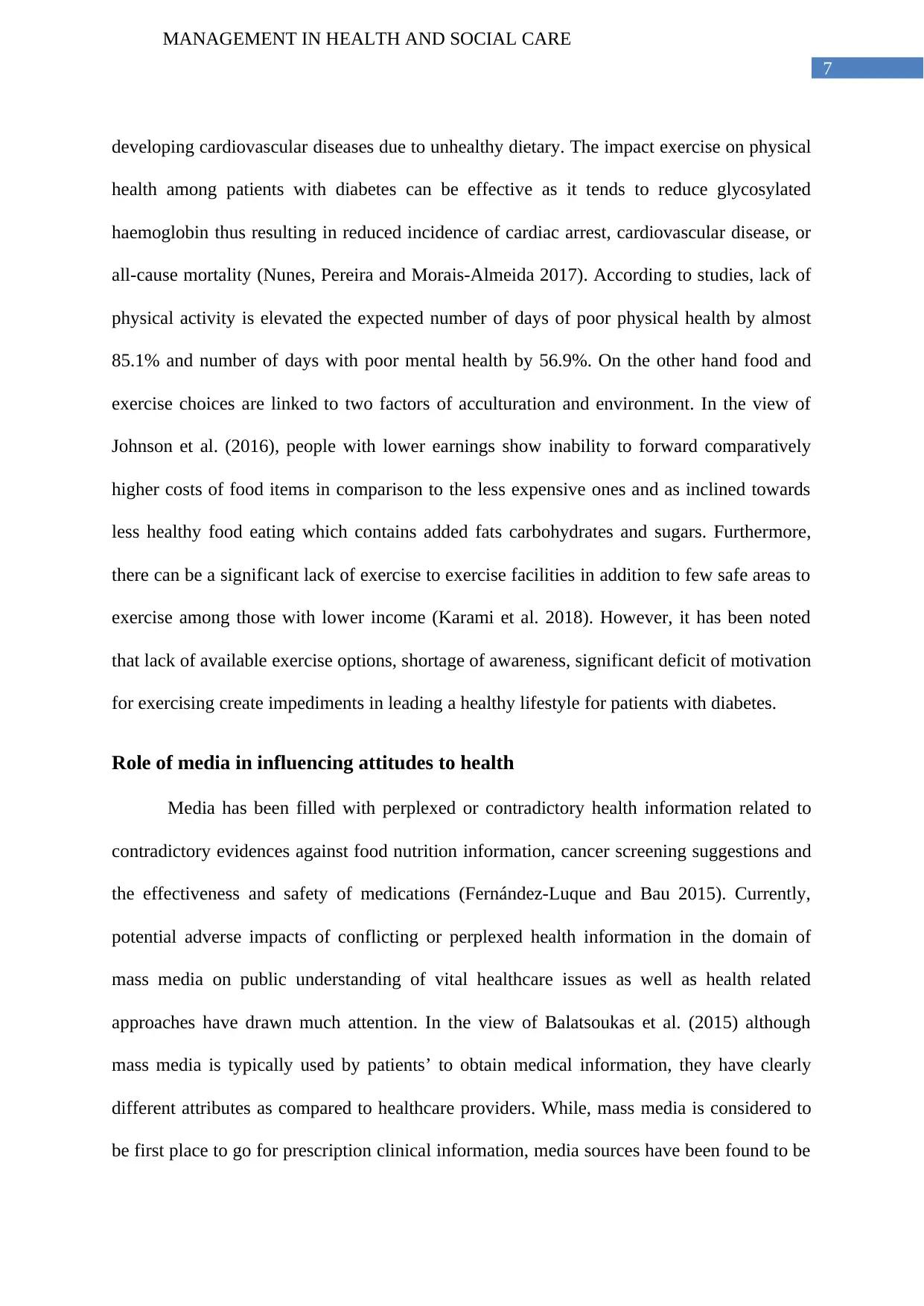
7
MANAGEMENT IN HEALTH AND SOCIAL CARE
developing cardiovascular diseases due to unhealthy dietary. The impact exercise on physical
health among patients with diabetes can be effective as it tends to reduce glycosylated
haemoglobin thus resulting in reduced incidence of cardiac arrest, cardiovascular disease, or
all-cause mortality (Nunes, Pereira and Morais-Almeida 2017). According to studies, lack of
physical activity is elevated the expected number of days of poor physical health by almost
85.1% and number of days with poor mental health by 56.9%. On the other hand food and
exercise choices are linked to two factors of acculturation and environment. In the view of
Johnson et al. (2016), people with lower earnings show inability to forward comparatively
higher costs of food items in comparison to the less expensive ones and as inclined towards
less healthy food eating which contains added fats carbohydrates and sugars. Furthermore,
there can be a significant lack of exercise to exercise facilities in addition to few safe areas to
exercise among those with lower income (Karami et al. 2018). However, it has been noted
that lack of available exercise options, shortage of awareness, significant deficit of motivation
for exercising create impediments in leading a healthy lifestyle for patients with diabetes.
Role of media in influencing attitudes to health
Media has been filled with perplexed or contradictory health information related to
contradictory evidences against food nutrition information, cancer screening suggestions and
the effectiveness and safety of medications (Fernández-Luque and Bau 2015). Currently,
potential adverse impacts of conflicting or perplexed health information in the domain of
mass media on public understanding of vital healthcare issues as well as health related
approaches have drawn much attention. In the view of Balatsoukas et al. (2015) although
mass media is typically used by patients’ to obtain medical information, they have clearly
different attributes as compared to healthcare providers. While, mass media is considered to
be first place to go for prescription clinical information, media sources have been found to be
MANAGEMENT IN HEALTH AND SOCIAL CARE
developing cardiovascular diseases due to unhealthy dietary. The impact exercise on physical
health among patients with diabetes can be effective as it tends to reduce glycosylated
haemoglobin thus resulting in reduced incidence of cardiac arrest, cardiovascular disease, or
all-cause mortality (Nunes, Pereira and Morais-Almeida 2017). According to studies, lack of
physical activity is elevated the expected number of days of poor physical health by almost
85.1% and number of days with poor mental health by 56.9%. On the other hand food and
exercise choices are linked to two factors of acculturation and environment. In the view of
Johnson et al. (2016), people with lower earnings show inability to forward comparatively
higher costs of food items in comparison to the less expensive ones and as inclined towards
less healthy food eating which contains added fats carbohydrates and sugars. Furthermore,
there can be a significant lack of exercise to exercise facilities in addition to few safe areas to
exercise among those with lower income (Karami et al. 2018). However, it has been noted
that lack of available exercise options, shortage of awareness, significant deficit of motivation
for exercising create impediments in leading a healthy lifestyle for patients with diabetes.
Role of media in influencing attitudes to health
Media has been filled with perplexed or contradictory health information related to
contradictory evidences against food nutrition information, cancer screening suggestions and
the effectiveness and safety of medications (Fernández-Luque and Bau 2015). Currently,
potential adverse impacts of conflicting or perplexed health information in the domain of
mass media on public understanding of vital healthcare issues as well as health related
approaches have drawn much attention. In the view of Balatsoukas et al. (2015) although
mass media is typically used by patients’ to obtain medical information, they have clearly
different attributes as compared to healthcare providers. While, mass media is considered to
be first place to go for prescription clinical information, media sources have been found to be
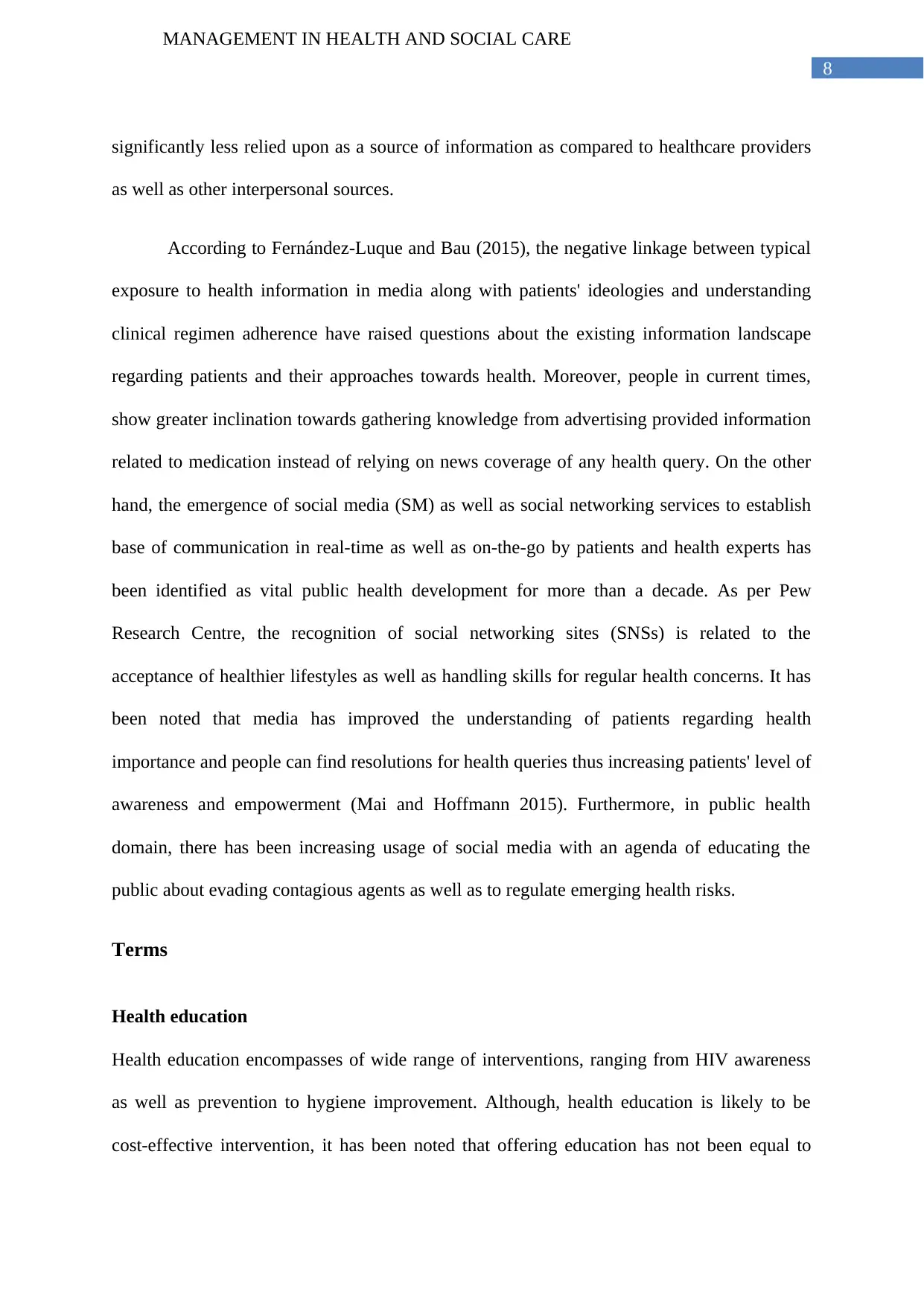
8
MANAGEMENT IN HEALTH AND SOCIAL CARE
significantly less relied upon as a source of information as compared to healthcare providers
as well as other interpersonal sources.
According to Fernández-Luque and Bau (2015), the negative linkage between typical
exposure to health information in media along with patients' ideologies and understanding
clinical regimen adherence have raised questions about the existing information landscape
regarding patients and their approaches towards health. Moreover, people in current times,
show greater inclination towards gathering knowledge from advertising provided information
related to medication instead of relying on news coverage of any health query. On the other
hand, the emergence of social media (SM) as well as social networking services to establish
base of communication in real-time as well as on-the-go by patients and health experts has
been identified as vital public health development for more than a decade. As per Pew
Research Centre, the recognition of social networking sites (SNSs) is related to the
acceptance of healthier lifestyles as well as handling skills for regular health concerns. It has
been noted that media has improved the understanding of patients regarding health
importance and people can find resolutions for health queries thus increasing patients' level of
awareness and empowerment (Mai and Hoffmann 2015). Furthermore, in public health
domain, there has been increasing usage of social media with an agenda of educating the
public about evading contagious agents as well as to regulate emerging health risks.
Terms
Health education
Health education encompasses of wide range of interventions, ranging from HIV awareness
as well as prevention to hygiene improvement. Although, health education is likely to be
cost-effective intervention, it has been noted that offering education has not been equal to
MANAGEMENT IN HEALTH AND SOCIAL CARE
significantly less relied upon as a source of information as compared to healthcare providers
as well as other interpersonal sources.
According to Fernández-Luque and Bau (2015), the negative linkage between typical
exposure to health information in media along with patients' ideologies and understanding
clinical regimen adherence have raised questions about the existing information landscape
regarding patients and their approaches towards health. Moreover, people in current times,
show greater inclination towards gathering knowledge from advertising provided information
related to medication instead of relying on news coverage of any health query. On the other
hand, the emergence of social media (SM) as well as social networking services to establish
base of communication in real-time as well as on-the-go by patients and health experts has
been identified as vital public health development for more than a decade. As per Pew
Research Centre, the recognition of social networking sites (SNSs) is related to the
acceptance of healthier lifestyles as well as handling skills for regular health concerns. It has
been noted that media has improved the understanding of patients regarding health
importance and people can find resolutions for health queries thus increasing patients' level of
awareness and empowerment (Mai and Hoffmann 2015). Furthermore, in public health
domain, there has been increasing usage of social media with an agenda of educating the
public about evading contagious agents as well as to regulate emerging health risks.
Terms
Health education
Health education encompasses of wide range of interventions, ranging from HIV awareness
as well as prevention to hygiene improvement. Although, health education is likely to be
cost-effective intervention, it has been noted that offering education has not been equal to
⊘ This is a preview!⊘
Do you want full access?
Subscribe today to unlock all pages.

Trusted by 1+ million students worldwide
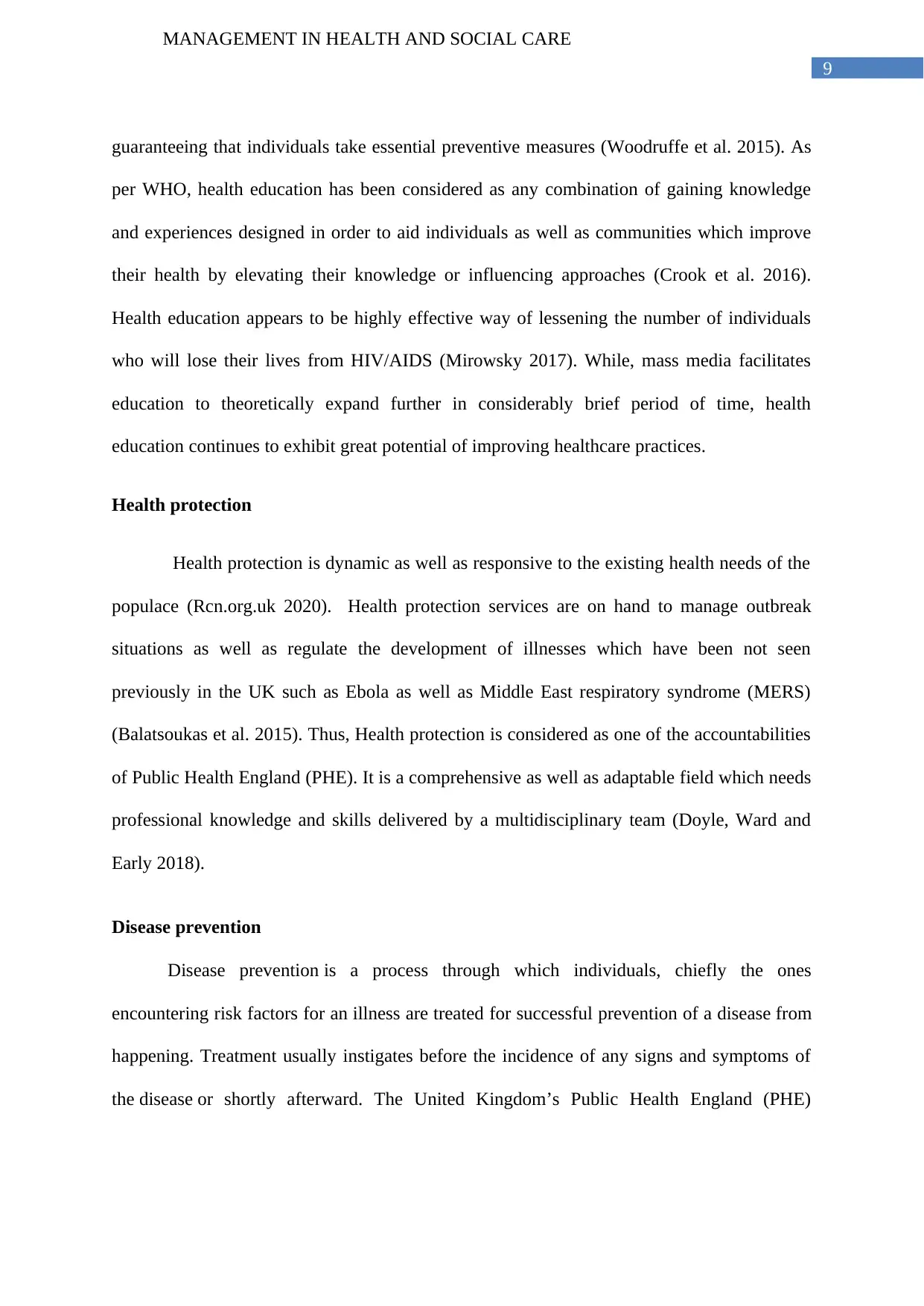
9
MANAGEMENT IN HEALTH AND SOCIAL CARE
guaranteeing that individuals take essential preventive measures (Woodruffe et al. 2015). As
per WHO, health education has been considered as any combination of gaining knowledge
and experiences designed in order to aid individuals as well as communities which improve
their health by elevating their knowledge or influencing approaches (Crook et al. 2016).
Health education appears to be highly effective way of lessening the number of individuals
who will lose their lives from HIV/AIDS (Mirowsky 2017). While, mass media facilitates
education to theoretically expand further in considerably brief period of time, health
education continues to exhibit great potential of improving healthcare practices.
Health protection
Health protection is dynamic as well as responsive to the existing health needs of the
populace (Rcn.org.uk 2020). Health protection services are on hand to manage outbreak
situations as well as regulate the development of illnesses which have been not seen
previously in the UK such as Ebola as well as Middle East respiratory syndrome (MERS)
(Balatsoukas et al. 2015). Thus, Health protection is considered as one of the accountabilities
of Public Health England (PHE). It is a comprehensive as well as adaptable field which needs
professional knowledge and skills delivered by a multidisciplinary team (Doyle, Ward and
Early 2018).
Disease prevention
Disease prevention is a process through which individuals, chiefly the ones
encountering risk factors for an illness are treated for successful prevention of a disease from
happening. Treatment usually instigates before the incidence of any signs and symptoms of
the disease or shortly afterward. The United Kingdom’s Public Health England (PHE)
MANAGEMENT IN HEALTH AND SOCIAL CARE
guaranteeing that individuals take essential preventive measures (Woodruffe et al. 2015). As
per WHO, health education has been considered as any combination of gaining knowledge
and experiences designed in order to aid individuals as well as communities which improve
their health by elevating their knowledge or influencing approaches (Crook et al. 2016).
Health education appears to be highly effective way of lessening the number of individuals
who will lose their lives from HIV/AIDS (Mirowsky 2017). While, mass media facilitates
education to theoretically expand further in considerably brief period of time, health
education continues to exhibit great potential of improving healthcare practices.
Health protection
Health protection is dynamic as well as responsive to the existing health needs of the
populace (Rcn.org.uk 2020). Health protection services are on hand to manage outbreak
situations as well as regulate the development of illnesses which have been not seen
previously in the UK such as Ebola as well as Middle East respiratory syndrome (MERS)
(Balatsoukas et al. 2015). Thus, Health protection is considered as one of the accountabilities
of Public Health England (PHE). It is a comprehensive as well as adaptable field which needs
professional knowledge and skills delivered by a multidisciplinary team (Doyle, Ward and
Early 2018).
Disease prevention
Disease prevention is a process through which individuals, chiefly the ones
encountering risk factors for an illness are treated for successful prevention of a disease from
happening. Treatment usually instigates before the incidence of any signs and symptoms of
the disease or shortly afterward. The United Kingdom’s Public Health England (PHE)
Paraphrase This Document
Need a fresh take? Get an instant paraphrase of this document with our AI Paraphraser
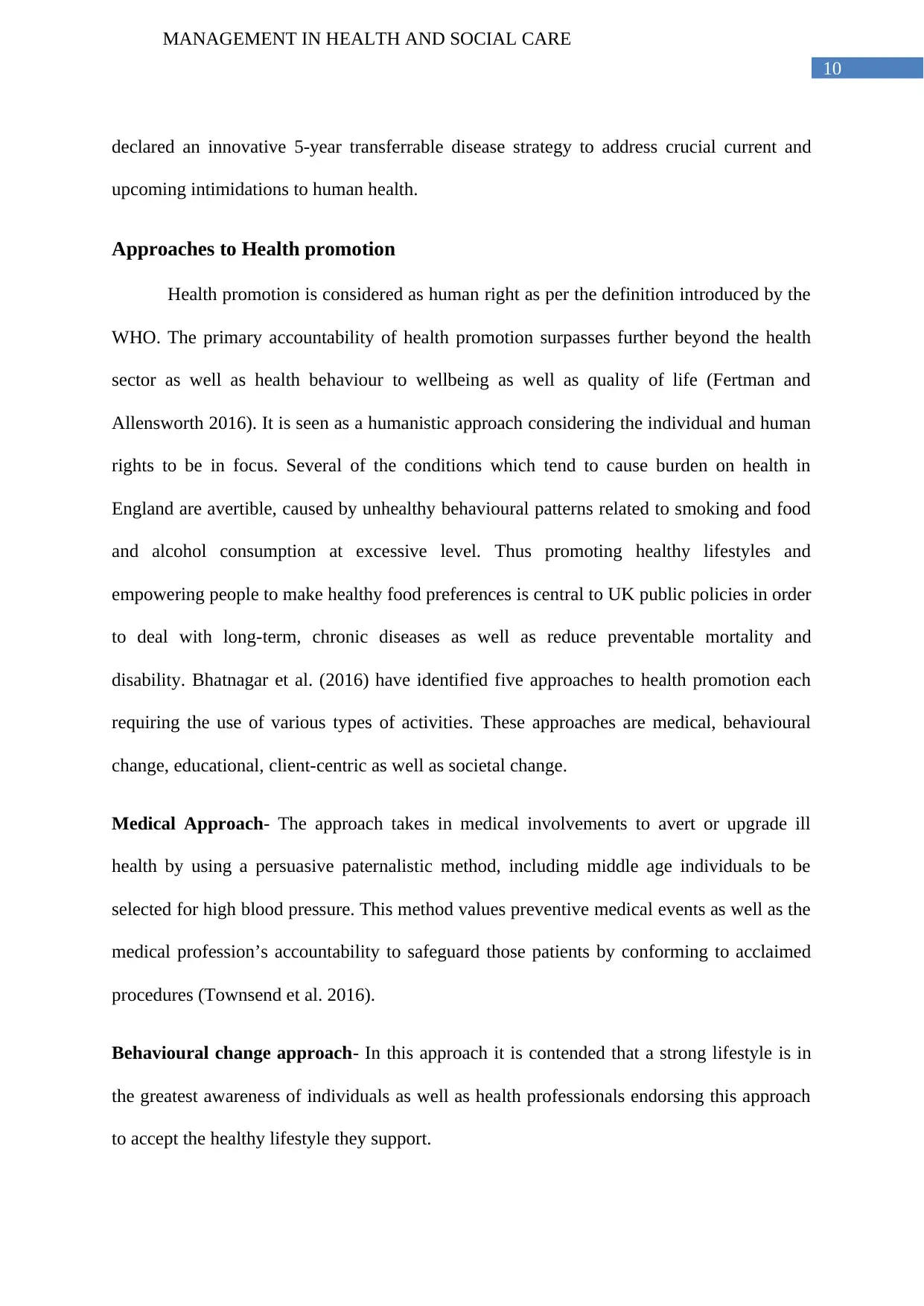
10
MANAGEMENT IN HEALTH AND SOCIAL CARE
declared an innovative 5-year transferrable disease strategy to address crucial current and
upcoming intimidations to human health.
Approaches to Health promotion
Health promotion is considered as human right as per the definition introduced by the
WHO. The primary accountability of health promotion surpasses further beyond the health
sector as well as health behaviour to wellbeing as well as quality of life (Fertman and
Allensworth 2016). It is seen as a humanistic approach considering the individual and human
rights to be in focus. Several of the conditions which tend to cause burden on health in
England are avertible, caused by unhealthy behavioural patterns related to smoking and food
and alcohol consumption at excessive level. Thus promoting healthy lifestyles and
empowering people to make healthy food preferences is central to UK public policies in order
to deal with long-term, chronic diseases as well as reduce preventable mortality and
disability. Bhatnagar et al. (2016) have identified five approaches to health promotion each
requiring the use of various types of activities. These approaches are medical, behavioural
change, educational, client-centric as well as societal change.
Medical Approach- The approach takes in medical involvements to avert or upgrade ill
health by using a persuasive paternalistic method, including middle age individuals to be
selected for high blood pressure. This method values preventive medical events as well as the
medical profession’s accountability to safeguard those patients by conforming to acclaimed
procedures (Townsend et al. 2016).
Behavioural change approach- In this approach it is contended that a strong lifestyle is in
the greatest awareness of individuals as well as health professionals endorsing this approach
to accept the healthy lifestyle they support.
MANAGEMENT IN HEALTH AND SOCIAL CARE
declared an innovative 5-year transferrable disease strategy to address crucial current and
upcoming intimidations to human health.
Approaches to Health promotion
Health promotion is considered as human right as per the definition introduced by the
WHO. The primary accountability of health promotion surpasses further beyond the health
sector as well as health behaviour to wellbeing as well as quality of life (Fertman and
Allensworth 2016). It is seen as a humanistic approach considering the individual and human
rights to be in focus. Several of the conditions which tend to cause burden on health in
England are avertible, caused by unhealthy behavioural patterns related to smoking and food
and alcohol consumption at excessive level. Thus promoting healthy lifestyles and
empowering people to make healthy food preferences is central to UK public policies in order
to deal with long-term, chronic diseases as well as reduce preventable mortality and
disability. Bhatnagar et al. (2016) have identified five approaches to health promotion each
requiring the use of various types of activities. These approaches are medical, behavioural
change, educational, client-centric as well as societal change.
Medical Approach- The approach takes in medical involvements to avert or upgrade ill
health by using a persuasive paternalistic method, including middle age individuals to be
selected for high blood pressure. This method values preventive medical events as well as the
medical profession’s accountability to safeguard those patients by conforming to acclaimed
procedures (Townsend et al. 2016).
Behavioural change approach- In this approach it is contended that a strong lifestyle is in
the greatest awareness of individuals as well as health professionals endorsing this approach
to accept the healthy lifestyle they support.
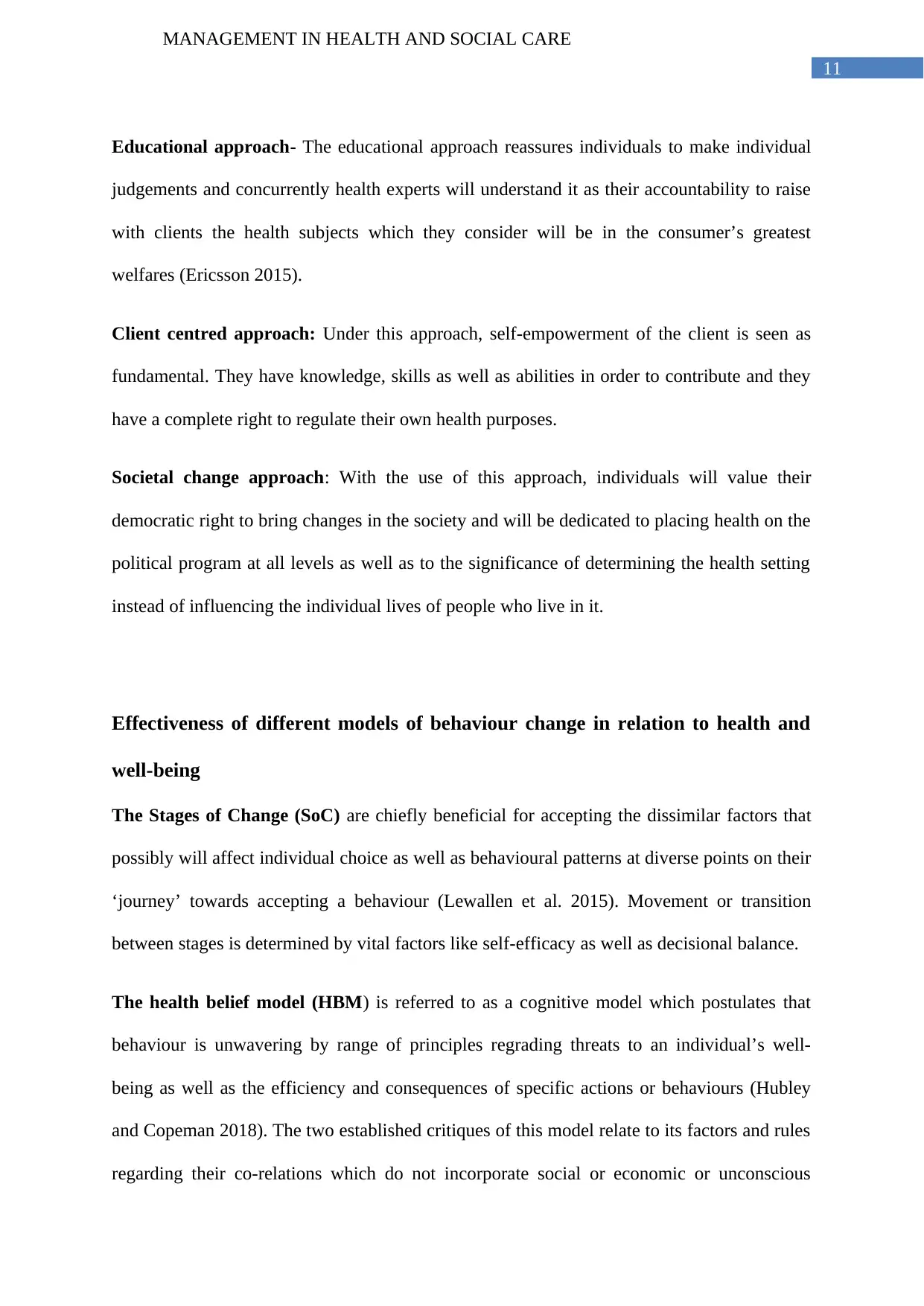
11
MANAGEMENT IN HEALTH AND SOCIAL CARE
Educational approach- The educational approach reassures individuals to make individual
judgements and concurrently health experts will understand it as their accountability to raise
with clients the health subjects which they consider will be in the consumer’s greatest
welfares (Ericsson 2015).
Client centred approach: Under this approach, self-empowerment of the client is seen as
fundamental. They have knowledge, skills as well as abilities in order to contribute and they
have a complete right to regulate their own health purposes.
Societal change approach: With the use of this approach, individuals will value their
democratic right to bring changes in the society and will be dedicated to placing health on the
political program at all levels as well as to the significance of determining the health setting
instead of influencing the individual lives of people who live in it.
Effectiveness of different models of behaviour change in relation to health and
well-being
The Stages of Change (SoC) are chiefly beneficial for accepting the dissimilar factors that
possibly will affect individual choice as well as behavioural patterns at diverse points on their
‘journey’ towards accepting a behaviour (Lewallen et al. 2015). Movement or transition
between stages is determined by vital factors like self-efficacy as well as decisional balance.
The health belief model (HBM) is referred to as a cognitive model which postulates that
behaviour is unwavering by range of principles regrading threats to an individual’s well-
being as well as the efficiency and consequences of specific actions or behaviours (Hubley
and Copeman 2018). The two established critiques of this model relate to its factors and rules
regarding their co-relations which do not incorporate social or economic or unconscious
MANAGEMENT IN HEALTH AND SOCIAL CARE
Educational approach- The educational approach reassures individuals to make individual
judgements and concurrently health experts will understand it as their accountability to raise
with clients the health subjects which they consider will be in the consumer’s greatest
welfares (Ericsson 2015).
Client centred approach: Under this approach, self-empowerment of the client is seen as
fundamental. They have knowledge, skills as well as abilities in order to contribute and they
have a complete right to regulate their own health purposes.
Societal change approach: With the use of this approach, individuals will value their
democratic right to bring changes in the society and will be dedicated to placing health on the
political program at all levels as well as to the significance of determining the health setting
instead of influencing the individual lives of people who live in it.
Effectiveness of different models of behaviour change in relation to health and
well-being
The Stages of Change (SoC) are chiefly beneficial for accepting the dissimilar factors that
possibly will affect individual choice as well as behavioural patterns at diverse points on their
‘journey’ towards accepting a behaviour (Lewallen et al. 2015). Movement or transition
between stages is determined by vital factors like self-efficacy as well as decisional balance.
The health belief model (HBM) is referred to as a cognitive model which postulates that
behaviour is unwavering by range of principles regrading threats to an individual’s well-
being as well as the efficiency and consequences of specific actions or behaviours (Hubley
and Copeman 2018). The two established critiques of this model relate to its factors and rules
regarding their co-relations which do not incorporate social or economic or unconscious
⊘ This is a preview!⊘
Do you want full access?
Subscribe today to unlock all pages.

Trusted by 1+ million students worldwide
1 out of 44
Related Documents
Your All-in-One AI-Powered Toolkit for Academic Success.
+13062052269
info@desklib.com
Available 24*7 on WhatsApp / Email
![[object Object]](/_next/static/media/star-bottom.7253800d.svg)
Unlock your academic potential
Copyright © 2020–2025 A2Z Services. All Rights Reserved. Developed and managed by ZUCOL.




